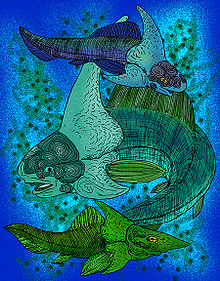Clidastes is an extinct genus of marine lizard belonging to the mosasaur family. It is classified as part of the Mosasaurinae subfamily, alongside genera like Mosasaurus and Prognathodon. Clidastes is known from deposits ranging in age from the Coniacian to the early Campanian in the United States.

Acanthothoraci is an extinct group of chimaera-like placoderms closely related to the rhenanid placoderms. Superficially, the acanthoracids resembled scaly chimaeras and (relatively) heavily armored ptyctodonts. They were distinguished from chimaeras by their large scales and plates, a pair of large spines that emanate from their chests, tooth-like beak plates, and the typical bone-enhanced placoderm eyeball. They were distinguished from other placoderms by differences in skull anatomy and by patterns on the skull plates and thoracic plates that are unique to this order.

The longnose sawtail catshark is a little-known species of catshark, part of the family Scyliorhinidae, found off the northwestern Pacific islands of Amami Ōshima, Ogasawara, and Izu at depths of 350–550 m (1,150–1,800 ft). Reaching a length of 80 cm (31 in), it is characterized by a long flattened snout, a long space between the pelvic and anal fins, and a crest of enlarged dermal denticles along the dorsal caudal fin edge. Adults are plain dark gray above, while juveniles have a few faint dark saddles on the back and tail.
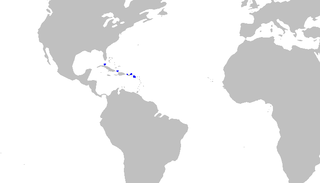
Springer's sawtail catshark is a species of catshark, belonging to the family Scyliorhinidae, found in waters 457–699 m (1,499–2,293 ft) deep off the islands of the Antilles, from Cuba to the Leewards. A small, slim-bodied species reaching a length of 48 cm (19 in), the Springer's sawtail catshark can be identified by its color pattern of horizontal dark stripes in front of the first dorsal fin, and dark dorsal saddles behind. It is additionally characterized by the presence of saw-toothed crests, made of enlarged dermal denticles along both the dorsal and the ventral edges of the caudal fin. The Springer's sawtail catshark is oviparous.

Weejasperaspididae is a family of three extinct acanthothoracid placoderms indigenous to the Early Devonian of Victoria and New South Wales, Australia.

Banji is an extinct genus of oviraptorid dinosaur that lived approximately 66 million years ago during the later part of the Cretaceous Period in what is now China. It was a small, lightly built, ground-dwelling, bipedal carnivore, that was an estimated 65 cm (2.1 ft) long, as a juvenile.
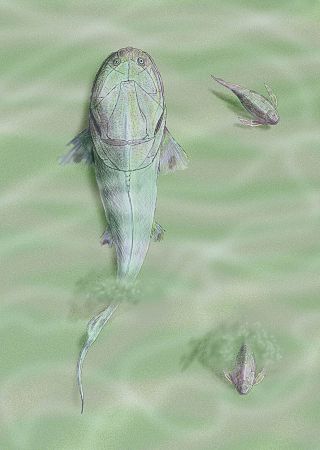
Homosteus is a genus of flattened arthrodire placoderm from the Middle Devonian. Fossils are found primarily in Eifelian-epoch aged strata of Europe, Canada, Greenland, and Estonia. All of the species had comparatively large, flattened heads with, as suggested by the upward opening orbits, upward-pointing eyes. These adaptations suggest that the various species were benthic predators. A study on Titanichthys, in contrast, suggests that species of Homosteus may have been filter-feeders instead.

Murrindalaspis is an extinct genus of acanthothoracid placoderm found in the McLarty Member of the Murrindal Limestone, of the Early Devonian-aged Buchan Group in eastern Victoria, Australia. Murrindalaspis differs from other acanthothoracids by having a dorsal plate with a large, blade-like flattened, recurved crest emanating from the medial line, and no ventral keel. So far, the genus is known only from dorsal plates and ossified eyeballs. The genus differs from the closely related Weejasperaspis in that the dorsal crest of the latter is shorter, and triangular-shaped.
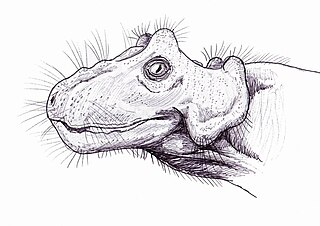
Paraburnetia is an extinct genus of biarmosuchian therapsids from the Late Permian of South Africa. It is known for its species P. sneeubergensis and belongs to the family Burnetiidae. Paraburnetia lived just before the Permian–Triassic mass extinction event.
Figaro is a genus of catshark, and part of the family Scyliorhinidae. Until 2008, Figaro was generally considered to be a subgenus of Galeus. The two known species are found off Australia, inhabiting deep, offshore waters on or near the bottom. Figaro contains small, slender, firm-bodied sharks that bear distinctive crests of enlarged, spiny dermal denticles along the dorsal and ventral edges of their short caudal fins. The caudal peduncle is relatively long, such as that the anal and caudal fins are some distance apart. In adult males, the inner margins of the pelvic fins are fused together to form a subtle "apron" over the claspers. F. boardmani is a predator of fishes, crustaceans, and cephalopods, and is oviparous; less is known about the F. striatus. Both are harmless and are of no economic importance.
The phallic catshark is a little-known species of catshark, belonging to the family Scyliorhinidae. It is found on or near the ocean floor, in the deep waters off New Caledonia and Vanuatu. A slender species attaining a length of 46 cm (18 in), it is characterized by a long caudal fin bearing a crest of enlarged dermal denticles along the dorsal margin, and very long claspers in adult males. This shark is gray-colored, with four dark saddles along the back and tail.

Siamodon is an extinct genus of iguanodontian ornithopod dinosaur from Early Cretaceous deposits of northeastern Thailand.
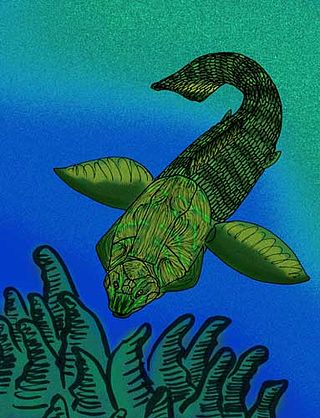
Holonematidae is an extinct family of relatively large arthrodire placoderms from the Early to Late Devonian. Almost all fossil specimens are of armor fragments, though, all have distinctive ornamentation, often of unique arrangements and patterns of tubercles, that are diagnostic of the family. The trunkshield is very elongated, giving the armor an overall "barrel" like appearance.

Belemnacanthus giganteus is a large, extinct, barrel-shaped holonematid arthrodire placoderm from Givetian-aged strata of Middle Devonian Eifel, Germany. B. giganteus is known only from the holotype, a 37 centimetres (15 in) portion of a median dorsal plate with a long, somewhat high, arching crest running down the median line of the exterior/dorsal side of the plate. The plate has an ornamentation of ridges that originate from a point posterior to the preserved portion of the median dorsal plate. Before the plate was identified as that of a holonematid, the plate of B. giganteus had been successively described as a tremendous spine of an elasmobranch, an agnathan, and lastly, the plate of an antiarch.

Rhenonema eifeliense is a large, extinct, high-crested holonematid arthrodire placoderm from Givetian-aged strata of Middle Devonian Gerolstein, Germany. It is known from some fragments of armor, including an anterior-lateral plate estimated to be around 24 centimetres (9.4 in) long, and a portion of a median dorsal plate with a very tall crest running along the median line of the dorsal surface. The ornamentation is very similar to that of Holonema, but the concentrically arranged ridges are much coarser in Rhenonema. The holotype was originally described by Kayser, in 1880, as a species of Dinichthys, but was then redescribed in 1964 by Obruchev as a holonematid.

Aspidichthys is a genus of large, distinctively tuberculated arthrodire placoderm of uncertain affinities from Upper Devonian marine strata in the Eastern United States and Europe.

Brachydeirus is a genus of small to moderately large-sized arthrodire placoderms from the Late Devonian of Europe, restricted to the Kellwasserkalk Fauna of Bad Wildungen and Adorf.

Oxyosteus is a genus of trout-sized, highly compressed arthrodire placoderms from the Late Devonian of Europe: The two described species are restricted to the Late Frasnian-aged Kellwasserkalk Fauna of Bad Wildungen, while a median dorsal plate of an unnamed species is known from the Middle Frasnian Holy Cross Mountains of Poland.

Qilinyu is a genus of early placoderm from the late Silurian of China. It contains a single species, Qilinyu rostrata, from the Xiaoxiang fauna of the Kuanti Formation. Along with its contemporary Entelognathus, Qilinyu is an unusual placoderm showing some traits more similar to bony fish, such as dermal jaw bones and lobe-like fins. It can be characterized by adaptations for a benthic lifestyle, with the mouth and nostrils on the underside of the head, similar to the unrelated antiarch placoderms. The shape of the skull has been described as "dolphin-like", with a domed cranium and a short projecting rostrum.

Wakinoichthys is a small freshwater fish from the Early Cretaceous of South Korea and Japan. Two species are currently known: W. aokii and W. robustus.
